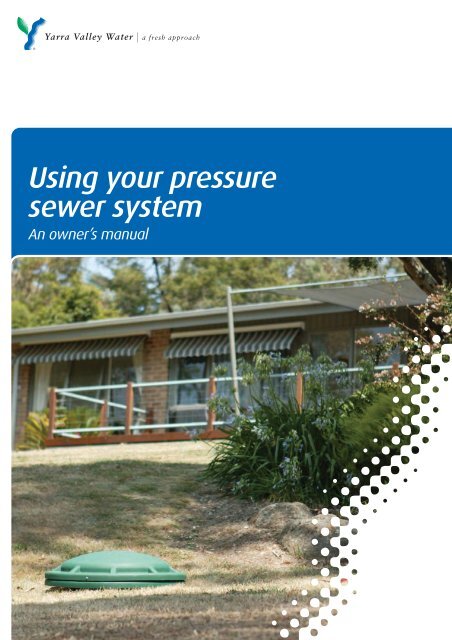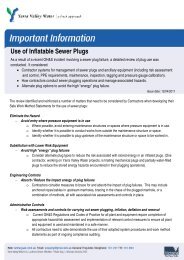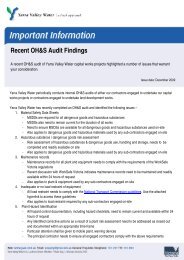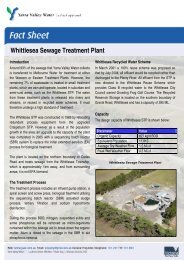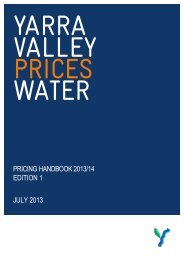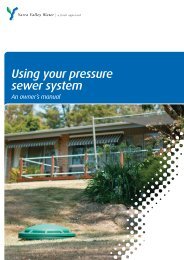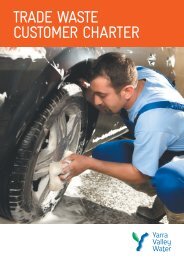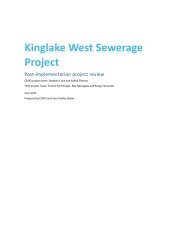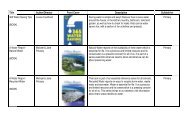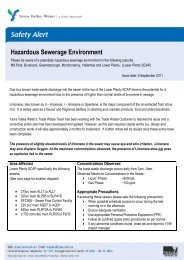What do I need to know about pressure sewer systems?
What do I need to know about pressure sewer systems?
What do I need to know about pressure sewer systems?
You also want an ePaper? Increase the reach of your titles
YUMPU automatically turns print PDFs into web optimized ePapers that Google loves.
Using your <strong>pressure</strong><br />
<strong>sewer</strong> system<br />
An owner’s manual
Using this manual<br />
This manual is a guide <strong>to</strong> the operation and maintenance of the <strong>pressure</strong> <strong>sewer</strong> system<br />
installed on your property. The system is easy <strong>to</strong> use and we strongly recommend that<br />
you take a few minutes <strong>to</strong> familiarise yourself with how it works.<br />
There are some basic things that you should <strong>know</strong> <strong>about</strong> your <strong>pressure</strong> <strong>sewer</strong> system.<br />
These include:<br />
• how <strong>to</strong> care for your unit<br />
• what happens if the alarm sounds<br />
• what procedures <strong>need</strong> <strong>to</strong> be put in place before you go on holiday.
Contents<br />
Using this manual<br />
<strong>What</strong> <strong>do</strong> I <strong>need</strong> <strong>to</strong> <strong>know</strong> <strong>about</strong> <strong>pressure</strong><br />
<strong>sewer</strong> <strong>systems</strong><br />
Why install a <strong>pressure</strong> <strong>sewer</strong> system<br />
<strong>What</strong> is a <strong>pressure</strong> <strong>sewer</strong><br />
<strong>What</strong> components make up a <strong>pressure</strong><br />
<strong>sewer</strong> system<br />
2<br />
3<br />
3<br />
3<br />
3<br />
How <strong>do</strong> <strong>pressure</strong> <strong>sewer</strong> <strong>systems</strong> work 4<br />
Important information<br />
<strong>What</strong> items must NOT be flushed <strong>do</strong>wn your household drains<br />
Why can’t rainwater go in<strong>to</strong> the <strong>pressure</strong> <strong>sewer</strong> system<br />
Why must I keep heavy weights off the lid<br />
5<br />
<strong>What</strong> happens if I want <strong>to</strong> extend my house<br />
or landscape the garden<br />
6<br />
House service line<br />
6<br />
Extensions <strong>to</strong> your house<br />
6<br />
Bungalows or other dwellings on your property 6<br />
Landscaping<br />
6<br />
Garages, car parks, decking, and garden sheds 6<br />
Installing a swimming pool or large spa<br />
6<br />
<strong>What</strong> special precautions <strong>do</strong> I <strong>need</strong> <strong>to</strong> take<br />
when going on holidays<br />
Going on holidays<br />
7<br />
7<br />
<strong>What</strong> you <strong>need</strong> <strong>to</strong> <strong>know</strong> <strong>about</strong> alarms 8<br />
Why is my alarm going off<br />
8<br />
Pumping unit repairs and warranties 9<br />
<strong>What</strong> happens if my pumping unit <strong>need</strong>s <strong>to</strong> be repaired 9<br />
Pumping unit servicing<br />
9<br />
Pressure <strong>sewer</strong> bursts<br />
9<br />
Warranties<br />
and repair costs<br />
9<br />
Conditions<br />
of connection<br />
10<br />
Using your <strong>pressure</strong> <strong>sewer</strong> system<br />
1
<strong>What</strong> <strong>do</strong> I <strong>need</strong> <strong>to</strong> <strong>know</strong> <strong>about</strong> <strong>pressure</strong> <strong>sewer</strong> <strong>systems</strong><br />
Why install a <strong>pressure</strong> <strong>sewer</strong><br />
system<br />
Pressure <strong>sewer</strong> <strong>systems</strong> are an economical<br />
and environmentally-friendly way of<br />
collecting, transporting and disposing of<br />
wastewater from households. They are often<br />
used in areas when the landscape is either<br />
very hilly or very flat, in areas which regularly<br />
flood or have high water tables, or where<br />
it is impractical <strong>to</strong> install other types of<br />
<strong>sewer</strong>age <strong>systems</strong>.<br />
<strong>What</strong> is a <strong>pressure</strong> <strong>sewer</strong><br />
system and how <strong>do</strong>es it work<br />
A <strong>pressure</strong> <strong>sewer</strong> system is made up of a<br />
network of fully sealed pipes which are fed by<br />
pumping units located at each connected<br />
property.<br />
The pumping unit processes the household<br />
wastewater and transfers it <strong>to</strong> the <strong>pressure</strong><br />
<strong>sewer</strong> located in the street via a small<br />
pipeline within the property. The <strong>pressure</strong><br />
<strong>sewer</strong> forms part of the overall pipe network<br />
which ultimately transfers the wastewater <strong>to</strong><br />
the nearest wastewater treatment facility –<br />
this could be within the surrounding area or<br />
many kilometers away.<br />
Once installed, the only visible parts of the<br />
<strong>pressure</strong> <strong>sewer</strong> system are the tank lid and<br />
control panel (see above).<br />
<strong>What</strong> components make up<br />
a <strong>pressure</strong> <strong>sewer</strong> system<br />
The <strong>pressure</strong> <strong>sewer</strong> system on your property<br />
is made up of four key elements, as shown<br />
in the diagram below.<br />
Pressure <strong>sewer</strong> system components<br />
1. Pumping unit<br />
This includes a small pump, s<strong>to</strong>rage tank,<br />
and level moni<strong>to</strong>rs which are all installed<br />
underground so that only the <strong>to</strong>p of the<br />
s<strong>to</strong>rage tank (or lid) is visible.<br />
street<br />
2<br />
Yarra Valley Water ownership<br />
cus<strong>to</strong>mer property<br />
lid<br />
capped<br />
inspection<br />
opening<br />
(27A)<br />
cus<strong>to</strong>mer<br />
ownership<br />
4<br />
2. Boundary valve kit<br />
Ensures that wastewater which is already<br />
in the <strong>pressure</strong> <strong>sewer</strong> cannot re-enter your<br />
property and enables maintenance staff <strong>to</strong><br />
isolate you from the system in the event of<br />
an emergency.<br />
3. House service line<br />
This is a small diameter pipe (not dissimilar<br />
<strong>to</strong> a large sprinkler system pipe) which<br />
connects the pumping unit on your property<br />
<strong>to</strong> the <strong>pressure</strong> <strong>sewer</strong> in the street.<br />
s<strong>to</strong>rage tank<br />
3<br />
<strong>pressure</strong><br />
<strong>sewer</strong><br />
boundary<br />
valve kit<br />
1<br />
pump<br />
riser<br />
property<br />
drain<br />
4. Control Panel<br />
This is a small box which is mounted <strong>to</strong><br />
the wall of your house containing all the<br />
electrical controls for the pumping unit<br />
including both the audible and visual<br />
alarm <strong>systems</strong>.
Pressure <strong>sewer</strong> <strong>systems</strong> are an economical<br />
and environmentally-friendly way of<br />
collecting, transporting and disposing of<br />
wastewater from households.<br />
How <strong>do</strong> <strong>pressure</strong> <strong>sewer</strong> <strong>systems</strong> work<br />
The main component of the <strong>pressure</strong> <strong>sewer</strong> system is the pumping unit which<br />
is installed on your property. The pumping unit works in the following way:<br />
STEP 1<br />
STEP 2<br />
Wastewater enters the<br />
s<strong>to</strong>rage tank from the<br />
household drains<br />
(including sinks, <strong>to</strong>ilets,<br />
showers, baths etc.)<br />
Alarm level<br />
Pump on<br />
The wastewater level<br />
rises above the “pump<br />
on” level and the pump<br />
au<strong>to</strong>matically turns on.<br />
Alarm level<br />
Pump on<br />
Pump off<br />
Pump off<br />
Water<br />
level<br />
rising<br />
STEP 3<br />
STEP 4<br />
When the wastewater<br />
level is reduced below<br />
the “pump off” level, the<br />
pump au<strong>to</strong>matically<br />
turns off.<br />
Alarm level<br />
Pump on<br />
Pump off<br />
Water<br />
level<br />
falling<br />
In the event of a power<br />
outage or pump failure,<br />
the wastewater level<br />
may rise above the “alarm<br />
level”.<br />
The audible and visible<br />
alarm will au<strong>to</strong>matically be<br />
activated.<br />
See the section titled<br />
“<strong>What</strong> you <strong>need</strong> <strong>to</strong> <strong>know</strong><br />
<strong>about</strong> alarms” for further<br />
instructions on what <strong>to</strong> <strong>do</strong><br />
if the alarm is activated.<br />
Alarm level<br />
Pump on<br />
Pump off<br />
Using your <strong>pressure</strong> <strong>sewer</strong> system<br />
2 | 3
The s<strong>to</strong>rage tank lid and boundary valve kit must not<br />
be covered by any landscaping works. You must also<br />
ensure that sufficient space is left around each of these<br />
components <strong>to</strong> enable access should it be required.<br />
Important information<br />
<strong>What</strong> items must NOT be<br />
flushed <strong>do</strong>wn your household<br />
drains<br />
It is very important that the following items<br />
are NOT flushed <strong>do</strong>wn any of your household<br />
drains (sinks, <strong>to</strong>ilets, showers, baths etc.) and<br />
in<strong>to</strong> the <strong>sewer</strong>age system, whether<br />
conventional or <strong>pressure</strong> system:<br />
• glass<br />
• metal or metal filings<br />
• seafood shells<br />
• goldfish s<strong>to</strong>nes<br />
• nappies, socks, rags or clothes<br />
• plastic objects<br />
• sanitary napkins or tampons<br />
• kitty litter<br />
• explosives<br />
• flammable materials<br />
• lubricating oil and/or grease<br />
• strong chemicals<br />
• gasoline<br />
• diesoline<br />
• rainwater<br />
Why can’t rainwater go in<strong>to</strong><br />
the <strong>pressure</strong> <strong>sewer</strong> system<br />
Pressure <strong>sewer</strong> <strong>systems</strong> are only designed<br />
<strong>to</strong> accept household wastewater, not<br />
s<strong>to</strong>rmwater or rainwater. Rainwater must not<br />
be directed in<strong>to</strong> the <strong>sewer</strong>age system<br />
for the following reasons:<br />
• it will increase the costs of pumping for<br />
you; and<br />
• it can lead <strong>to</strong> alarms being activated; and<br />
• in extreme situations, the pumping unit<br />
may overflow.<br />
If the alarm regularly activates during or after<br />
rainfall, you should contact Yarra Valley Water.<br />
Why must I keep heavy<br />
weights off the lid<br />
The lid of the s<strong>to</strong>rage tank is not strong<br />
enough <strong>to</strong> withstand the weight of very<br />
heavy objects (greater than 500 kilograms).<br />
As a guide, the following items should be<br />
kept off the lid.<br />
• Cars and other vehicles<br />
• Ride-on lawn mowers.<br />
If the pumping unit fails due <strong>to</strong> any of the<br />
above items entering the s<strong>to</strong>rage tank, the<br />
cus<strong>to</strong>mer may be responsible for meeting the<br />
cost of any repairs.<br />
If you are unsure <strong>about</strong> what items can go<br />
in<strong>to</strong> the <strong>pressure</strong> <strong>sewer</strong> system, please call<br />
Yarra Valley Water on 13 2989.
To turn off the audible alarm, press the but<strong>to</strong>n<br />
on the underside of the control panel. The<br />
flashing light will only turn off if one of our<br />
representatives resets it, or the problem which<br />
has triggered the alarm is resolved.<br />
<strong>What</strong> you <strong>need</strong> <strong>to</strong> <strong>know</strong> <strong>about</strong> alarms<br />
Why is my alarm going off<br />
There are a number of reasons why your alarm may be activated. The following table provides you with a step-by-step guide <strong>to</strong> dealing with an<br />
alarm activation.<br />
Symp<strong>to</strong>m Action How <strong>to</strong> <strong>do</strong> it<br />
Alarm sounds Turn off the audible alarm • press the but<strong>to</strong>n on the underside of the control panel <strong>to</strong> disable the audible alarm<br />
• the audible alarm will au<strong>to</strong>matically shut off after a period of time (regardless of whether the but<strong>to</strong>n on the<br />
underside of the control panel is pressed).<br />
Flashing light Report alarm activation • the flashing light will only turn off if one of our representatives resets it, or the problem which has<br />
triggered the alarm is resolved.<br />
Power outage Wait one hour before reporting • if the alarm activates following a power outage, please wait for one hour before contacting us<br />
• the alarm may sound when the power is res<strong>to</strong>red as the wastewater level in the s<strong>to</strong>rage tank may<br />
have built up <strong>to</strong> above the alarm level<br />
• once power is res<strong>to</strong>red, the pump will recommence pumping but may take up <strong>to</strong> an hour for the<br />
wastewater level in the tank <strong>to</strong> drop below the alarm level (this is due <strong>to</strong> a number of other pumps trying<br />
<strong>to</strong> empty their tanks at the same time)<br />
• you should attempt <strong>to</strong> minimise wastewater generation during power outages <strong>to</strong> minimize the amount that<br />
the wastewater level in the s<strong>to</strong>rage tank rises.<br />
Power outage for Minimise wastewater • take steps <strong>to</strong> minimise wastewater generation by:<br />
longer than eight hours generation and advise us – not turning on clothes washers while the alarm is active. If washing is urgent, bucket water from the clothes<br />
washer on<strong>to</strong> the lawn as a short-term measure (<strong>do</strong> not <strong>do</strong> this if cleaning products are low phosphate)<br />
– keep showers brief<br />
– where a bath was filled, leave the plug in until after the alarm is cancelled or bucket out the water<br />
on<strong>to</strong> the lawn<br />
– switch off any drainage (au<strong>to</strong>mated or not) from swimming pools or spas until after the power is res<strong>to</strong>red<br />
• advise us of extended power outages, particularly if it appears that the duration may exceed eight<br />
hours (excluding time when the residents are asleep)<br />
• in the event of extended power outage events, we may <strong>need</strong> <strong>to</strong> organise for your s<strong>to</strong>rage tank <strong>to</strong> be pumped out.<br />
If alarm sounds frequently Investigate • determine if there is any sudden discharge (such as from a swimming pool) and see whether the<br />
and then turns off<br />
alarm is in response <strong>to</strong> this<br />
• if the alarm sounds during or after rainfall, rainwater may be entering the s<strong>to</strong>rage tank<br />
• should the problem continue <strong>to</strong> occur, please contact us <strong>to</strong> investigate and repair as appropriate.<br />
If your neighbour’s Contact us • if you suspect your neighbour is not home, please contact us <strong>to</strong> inspect the property<br />
alarm sounds<br />
• the audible alarm will au<strong>to</strong>matically shut off after a period of time.<br />
Officer attends Create clear access • ensure our officer has access <strong>to</strong> and from the pumping unit as transportation of a faulty pump may be required.<br />
!<br />
Please call 13 2762 <strong>to</strong> report any alarms.<br />
Using your <strong>pressure</strong> <strong>sewer</strong> system<br />
4 | 5
<strong>What</strong> happens if I want <strong>to</strong> extend my house or landscape the garden<br />
House service line<br />
The house service line is a polyethylene<br />
<strong>sewer</strong> pipe which connects the pumping unit<br />
on your property <strong>to</strong> the <strong>pressure</strong> <strong>sewer</strong> in the<br />
street. It is worth familiarising yourself with<br />
the exact location of the house service line so<br />
that it can be moved (if required) or avoided if<br />
work is being <strong>do</strong>ne on your property.<br />
The house service line can be found using<br />
one of the following methods:<br />
• detectable marker tape is buried just<br />
above the pipeline and can be located<br />
by your builder<br />
• if your builder cannot detect the tape,<br />
contact us on 13 2989 and an officer will<br />
peg the line for you at a cost.<br />
Extensions <strong>to</strong> your house<br />
If you are extending your house, you must<br />
contact Yarra Valley Water <strong>to</strong> seek advice on<br />
the suitability of your existing pumping unit<br />
prior <strong>to</strong> the commencement of any<br />
construction activities.<br />
Moving the pumping unit will be dependent<br />
on the layout of your land as all wastewater<br />
from your house must gravitate in<strong>to</strong> it.<br />
If we approve your application, the costs<br />
associated with moving the pumping unit and<br />
house service line will be your responsibility (a<br />
quotation will be provided <strong>to</strong> you prior <strong>to</strong> works<br />
being carried out). Any changes <strong>to</strong> the original<br />
installation <strong>need</strong> <strong>to</strong> be clearly <strong>do</strong>cumented and<br />
submitted <strong>to</strong> us <strong>to</strong> ensure that in the event of<br />
an emergency, our maintenance staff can<br />
locate the key system components.<br />
Bungalows or other dwellings<br />
on your property<br />
It may be possible for your pumping unit <strong>to</strong><br />
service both the main and additional<br />
dwellings on your property, depending on the<br />
layout of your land.<br />
Please contact us for advice in relation <strong>to</strong><br />
this matter.<br />
Landscaping<br />
Landscaping over the house service line is<br />
permitted, please bear in mind that if repairs<br />
are required, you will be responsible for the<br />
costs of any reinstatement works <strong>to</strong> repair<br />
any damage caused.<br />
The s<strong>to</strong>rage tank lid and boundary valve kit<br />
must not be covered by any landscaping<br />
works. You must also ensure that sufficient<br />
space is left around each of these components<br />
<strong>to</strong> enable our maintenance staff <strong>to</strong> access<br />
them if required.<br />
Garages, car parks, decking<br />
and garden sheds<br />
Garages, car parks, decking and garden<br />
sheds should not be built over the pumping<br />
unit or house service line without our prior<br />
approval. It is likely that if you wish <strong>to</strong><br />
construct any of these structures, we will<br />
recommend relocating the house service line<br />
if possible.<br />
In no circumstances can any of these<br />
structures be built over the pumping unit or<br />
boundary valve kit.<br />
Installing a swimming pool or<br />
large spa<br />
Installing a swimming pool or large spa can<br />
result in large amounts of water being<br />
discharged quickly <strong>to</strong> the pumping unit<br />
during activities such as backwashing filters<br />
or emptying.<br />
In some cases, the pumping unit may not be<br />
able <strong>to</strong> cope with this and the alarm may<br />
activate or the pumping unit may even<br />
overflow.<br />
Please contact us for advice in relation <strong>to</strong> this<br />
matter.<br />
!<br />
If you are thinking <strong>about</strong> installing a swimming pool or spa, contact us and we will provide<br />
advice on how <strong>to</strong> avoid potential problems.
If you are extending your house, you must<br />
contact us <strong>to</strong> seek advice on the suitability<br />
of your existing pumping unit prior <strong>to</strong> any<br />
construction activities.<br />
<strong>What</strong> special precautions <strong>do</strong> I <strong>need</strong> <strong>to</strong> take when going on holidays<br />
Going on holidays<br />
If you are going on holidays for more than three days, your pumping unit will<br />
<strong>need</strong> <strong>to</strong> be flushed out <strong>to</strong> prevent potential o<strong>do</strong>ur problems.<br />
It is suggested that you complete the following activities before going away:<br />
Flush the system<br />
Run clean water in<strong>to</strong> the pumping unit until the pump activates and runs for <strong>about</strong> 30<br />
seconds. After that time, turn off the water and allow the pump <strong>to</strong> run until it shuts off<br />
au<strong>to</strong>matically.<br />
You can <strong>do</strong> this by filling up the bathtub and then emptying it.<br />
Keep the power <strong>to</strong> the pumping unit turned on at all times<br />
If there are any leaking taps or appliances within your household, there may be a small<br />
accumulation of wastewater in the s<strong>to</strong>rage tank. If the pumping unit is turned off, it<br />
could potentially overflow and there would be no audible or visible alarm <strong>to</strong> warn you or<br />
your neighbours of the problem.<br />
ON<br />
OFF<br />
Flush the system by filling the bathtub and then emptying it<br />
Ensure the pumping unit is turned on at all times<br />
!<br />
If you fail <strong>to</strong> clean your system before going on holidays and we have <strong>to</strong> flush out your s<strong>to</strong>rage tank in<br />
response <strong>to</strong> complaints from residents in the area, you may be required <strong>to</strong> pay for the costs of this work.<br />
Using your <strong>pressure</strong> <strong>sewer</strong> system<br />
6 | 7
Pumping unit repairs and warranties<br />
<strong>What</strong> happens if my pumping unit <strong>need</strong>s <strong>to</strong> be repaired<br />
Pumping unit repairs are generally simple. In most cases, maintenance staff will be able <strong>to</strong> make immediate repairs <strong>to</strong> your pumping unit.<br />
If the problem is more serious, your pumping unit may be replaced immediately and taken back <strong>to</strong> our workshop for repairs. Repairs and/or<br />
replacement of the pumping unit will normally be completed within an hour of our officer arriving at your property.<br />
System part Action <strong>What</strong> will we <strong>do</strong><br />
Pumping unit Contact us • we will carry out repairs <strong>to</strong> all points of the <strong>pressure</strong> <strong>sewer</strong> system<br />
• owners will not incur any cost for repairs which result from the normal operation of the system<br />
• a replacement pump will be inserted in<strong>to</strong> the s<strong>to</strong>rage tank if the existing pump requires significant repairs.<br />
Sewer or pump repairs Minimise wastewater production • if repairs are required <strong>to</strong> the <strong>pressure</strong> <strong>sewer</strong> or the pumping unit, you should minimise wastewater<br />
production until repairs are completed.<br />
Boundary valve Do not access them yourself. • we will operate the valves in your boundary valve kit if required<br />
kit repairs Contact us and wait for our • under no circumstances should owners open or tamper with the valves inside the boundary valve kit.<br />
officer <strong>to</strong> operate valves<br />
Pumping unit servicing<br />
The average pumping unit only requires<br />
servicing once every eight years.<br />
Please report any pumping unit faults <strong>to</strong> us.<br />
Pressure <strong>sewer</strong> bursts<br />
If you notice wet ground or water escaping<br />
from your plumbing, it is possible that a burst<br />
may have occurred.<br />
Such breaks are rare and are more likely <strong>to</strong><br />
occur due <strong>to</strong> other work being carried out<br />
near the pipes.<br />
If you become aware of such a fault, please<br />
contact us (on 13 2762) immediately.<br />
Following this, try <strong>to</strong> minimise water usage<br />
until the problem is fixed.<br />
Warranties and repair costs<br />
Pumping unit warranty<br />
Only our licensed representatives carry out<br />
repairs on the pumping unit.<br />
Work by others that was not authorised by us<br />
in writing may void warranties and you may<br />
become liable for future costs.<br />
Replacement<br />
If pumping units require replacement, you will<br />
not be required <strong>to</strong> meet any of these costs.<br />
The only exceptions <strong>to</strong> this rule are if you have:<br />
• emptied substances in<strong>to</strong> the pumping unit<br />
which are banned as shown earler<br />
• accessed the pumping unit. The s<strong>to</strong>rage<br />
tank lid must remain sealed at all times<br />
and warranties are exempt if you open it<br />
• interfered with the house service line or<br />
boundary valve kit<br />
• blocked off the vents <strong>to</strong> the s<strong>to</strong>rage tank<br />
by covering it over.
Conditions of connection<br />
1. Preliminary<br />
1.1 In these conditions:<br />
you and your refer <strong>to</strong> the owner of the<br />
property connected, or <strong>to</strong> be connected, <strong>to</strong><br />
our <strong>pressure</strong> <strong>sewer</strong> system.<br />
we, us and our refer <strong>to</strong> Yarra Valley Water.<br />
1.2 Either our cus<strong>to</strong>mer charter for residential<br />
cus<strong>to</strong>mers or our cus<strong>to</strong>mer charter for<br />
business cus<strong>to</strong>mers is incorporated with<br />
these conditions. Any of your obligations set<br />
out in our <strong>pressure</strong> <strong>sewer</strong> system manual<br />
are also incorporated with these conditions.<br />
If there is any inconsistency with either of<br />
them, these conditions prevail.<br />
2. Power<br />
We will arrange for the pumping unit <strong>to</strong> be<br />
connected <strong>to</strong> the power supply <strong>to</strong> your property.<br />
You must pay the cost of this connection <strong>to</strong> us.<br />
You must also pay for the power used by the pump.<br />
3. Property drain<br />
We will arrange for the installation or alteration of<br />
your property drain. You must pay the cost of that<br />
work.<br />
4. Installation<br />
We will arrange <strong>to</strong> install the pumping unit<br />
control panel, electrical cables, and the pipes on<br />
our side of the pumping unit, and will meet the<br />
cost of such work.<br />
5. Maintenance<br />
5.1 You must arrange <strong>to</strong> maintain your property<br />
drain and keep it in good working order.<br />
Any work on your property drain must be<br />
<strong>do</strong>ne by a licensed plumber. You must pay<br />
for such maintenance.<br />
5.2 We will maintain the pumping unit, the control<br />
panel, electrical cables and all pipes on our<br />
side of the capped inspection opening (27A).<br />
We will arrange for and pay for such work.<br />
5.3 You must notify us promptly on our<br />
Emergency and Faults telephone line (132<br />
762) when you discover anything wrong with<br />
the pumping unit (including any power<br />
failure), the control panel, electrical cables,<br />
or the pipes on our side of the pumping unit.<br />
6. Damage<br />
6.1 If you, or someone else for whom we are<br />
not responsible, damages the pumping<br />
unit, the control panel, electrical cables, or<br />
pipes on our side of the pumping unit, we<br />
will arrange for repairs <strong>to</strong> be made. You<br />
must pay us the cost of any such repairs.<br />
6.2 If we, or someone for whom we are<br />
responsible, damages your land or anything<br />
on it while carrying out work referred <strong>to</strong> in<br />
the above items, the legislation under which<br />
we operate requires us <strong>to</strong> compensate you<br />
for the damage.<br />
7. Our contribution <strong>to</strong> your costs<br />
7.1 Should connection <strong>to</strong> the <strong>pressure</strong> <strong>sewer</strong><br />
system be made after the original system is<br />
installed, a remobilisation fee will apply.<br />
This fee represents the actual additional<br />
cost incurred by Yarra Valley Water as a<br />
result of having <strong>to</strong> perform a one-off<br />
installation.<br />
8. Pools and spas<br />
8.1 If you have a pool or spa which discharges<br />
water at more than 0.5 litres per second<br />
when it is emptied or the filter is<br />
backwashed (this should be specified in<br />
your pool or spa user manual), you must<br />
limit the flow <strong>to</strong> the pumping unit by<br />
installing either:<br />
(a) an intermediate holding tank<br />
(b) a duplex pump arrangement<br />
(c) flow limiting valve<br />
The installation must be <strong>do</strong>ne by a licensed<br />
plumber.<br />
8.2 You must meet the cost of purchasing,<br />
installing and maintaining the holding tank,<br />
flow limiting valve, or duplex pump unit<br />
including any work (installation or<br />
maintenance) performed by a licensed<br />
plumber.<br />
9. Restricting water use<br />
Whenever you discover anything wrong with the<br />
pumping unit (including any power failure) or<br />
your property drain, you must restrict as much as<br />
possible the amount of water that is sent <strong>do</strong>wn<br />
your property drains.<br />
This will reduce the amount of wastewater<br />
generated from your property while the<br />
fault persists thereby helping avoid an<br />
overflow at the tank unit.<br />
10.Pressure <strong>sewer</strong> system manual<br />
10.1 You must ensure that a copy of the<br />
<strong>pressure</strong> <strong>sewer</strong> system manual is kept at<br />
the property at all times, even if the<br />
property is leased or rented.<br />
10.2 You can obtain further copies of the<br />
<strong>pressure</strong> <strong>sewer</strong> system manual from our<br />
website at www.yvw.com.au.<br />
11.Decommissioning old <strong>systems</strong><br />
When our <strong>pressure</strong> <strong>sewer</strong> system is installed,<br />
you must arrange for a licensed plumber <strong>to</strong><br />
decommission your existing wastewater system,<br />
in accordance with EPA requirements for such<br />
work. You must pay for this work.<br />
12.Selling your property<br />
When we provide any information statements<br />
<strong>about</strong> your property (for example, <strong>to</strong> a potential<br />
purchaser) it will state that the property is in a<br />
<strong>pressure</strong> <strong>sewer</strong> area and that special conditions<br />
of connection apply <strong>to</strong> it.<br />
13.Costs and charges<br />
13.1 If you are in a backlog area, you must pay<br />
the relevant backlog <strong>sewer</strong>age connection<br />
contribution once a connection point <strong>to</strong><br />
your property is provided. This<br />
contribution is payable in quarterly<br />
installments over five years.<br />
13.2 If your property is in a backlog area and<br />
was provided with a <strong>sewer</strong>age<br />
connection point after 1 July 2008, you<br />
are eligible for a backlog <strong>sewer</strong>age<br />
connection contribution rebate provided<br />
you connect within 12 months.<br />
13.3 If you are not in a backlog area, you<br />
must pay the full costs associated with<br />
supply and installation of the pumping<br />
unit as well as any required network<br />
extensions or augmentations.<br />
13.4 You must also meet the <strong>sewer</strong>age service<br />
and usage charges which apply <strong>to</strong> all<br />
residential or business properties.<br />
Using your <strong>pressure</strong> <strong>sewer</strong> system<br />
8 | 9
Further information<br />
For more information contact Yarra Valley Water<br />
Telephone: 13 2989<br />
Email: enquiry@yvw.com.au<br />
Web: www.yvw.com.au<br />
Emergencies and faults telephone: 13 1762<br />
Language assistance telephone: 13 1450<br />
General Enquiries:<br />
Tel: 13 1721 TIS: 13 1450 Email: enquiry@yvw.com.au Web: www.yvw.com.au<br />
Yarra Valley Water Ltd, Luc<strong>know</strong> Street, Mitcham Vic<strong>to</strong>ria 3132<br />
Printed on Australian-made 100% recycled paper.


